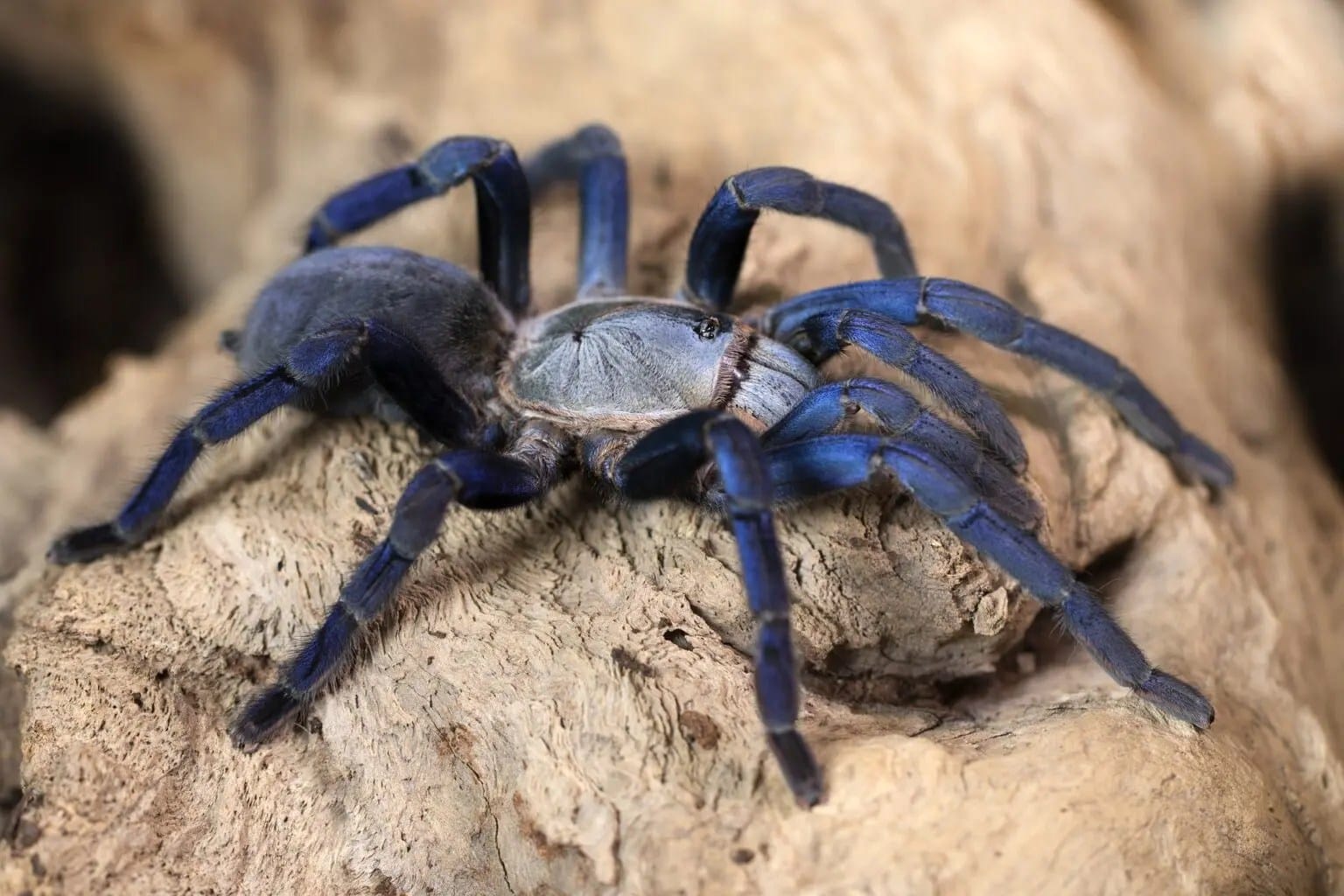Hey there, tarantula enthusiasts! Prepare to be amazed by the captivating world of blue tarantulas. These rare beauties are like living jewels, boasting shades of blue that would make a kingfisher jealous. But there’s more to these spiders than their stunning looks. Join us as we uncover the secrets of their vibrant colors, delve into their unique care requirements, and address the critical importance of conservation for these elusive creatures.
Beyond the Blue: Unveiling the Rarity of Blue Tarantulas
You’re right to be curious about blue tarantulas – they’re not your average spider! Out of the nearly 900 known tarantula species, only a small fraction, around 4%, display those captivating blue hues. This rarity makes them highly sought after in the world of arachnid enthusiasts.
What makes blue so rare in nature? It all comes down to the complex physical and chemical processes needed to produce blue pigments and structural colors. This rarity extends beyond spiders, as blue is less common in flowers, birds, and insects compared to other colors.
The Science Behind the Sparkle: How Do They Get That Blue?
You might think it’s simple pigmentation, but the science behind blue tarantulas is much more fascinating! Imagine microscopic structures, called nanostructures, on their exoskeletons. These structures act like tiny prisms, manipulating light to create that stunning blue appearance.
This phenomenon, known as “structural coloration,” is similar to how the sky appears blue due to scattered sunlight. While the exact evolutionary advantages of blue coloration in tarantulas are still being researched, some scientists theorize it could play a role in:
- Camouflage: Blending in with dappled light in their natural environment.
- Mate Attraction: A vibrant display to attract potential mates.
- Warning Signals: Deterring predators with a signal of potential toxicity.
A Spectrum of Blue: Notable Species
From vibrant electric blues to deep cobalt hues, these eight-legged wonders showcase a mesmerizing range of blue shades. Here are some notable blue tarantulas:
- Chilobrachys natanicharum (Electric Blue Tarantula): Recently discovered in Thailand, this species sets itself apart with its intensely vibrant blue legs, mouthparts, and even parts of its back.
- Poecilotheria metallica (Gooty Sapphire Ornamental Tarantula): This critically endangered species hails from India and is highly prized for its breathtaking metallic blue coloration and intricate markings.
- Other Blue Beauties: Not all blue tarantulas are created equal. The Cobalt Blue (Haplopelma lividum), the Greenbottle Blue (Chromatopelma cyaneopubescens), and the Brazilian Blue (Pterinopelma sazimai) each boast their own unique shades of blue, adding to the diversity of this captivating group.
Interested in learning more about other fascinating creatures? Check out our articles on beautiful butterflies, the intriguing bird spider, and the bizarre black swallower fish.
Thinking of Welcoming a Blue Tarantula Home?
The allure of owning a blue tarantula is undeniable, but is it the right choice for you? Before you’re smitten by their beauty, let’s take a closer look at the realities of caring for these exotic creatures.
Not Your Average Pet
Owning a blue tarantula is more than just a fashion statement; it’s a commitment to providing for the unique needs of a sensitive and often misunderstood creature. Here are some key factors to consider:
- Specialized Care: Blue tarantulas are not beginner pets. They require a carefully controlled environment with specific temperature, humidity, and substrate requirements.
- Dietary Needs: Forget kibble – these are carnivores with a taste for live prey! Prepare to become acquainted with crickets, roaches, and other insects that form their natural diet.
- Limited Handling: While not inherently aggressive, blue tarantulas are easily stressed and prefer to avoid handling. Excessive interaction can be detrimental to their well-being.
Conservation and Ethical Considerations
The popularity of blue tarantulas, sadly, has contributed to the illegal pet trade, further endangering already vulnerable wild populations. If you’re considering a blue tarantula as a pet, here’s what you need to know:
- Responsible Sourcing: Always choose captive-bred tarantulas from reputable breeders. This helps to protect wild populations and ensures your pet has been raised ethically.
- Long-Term Commitment: Tarantulas can live for many years, requiring ongoing care and attention. Be prepared to provide for their needs for the entirety of their lifespan.
Are All Blue Tarantulas Created Equal?
While the term “blue tarantula” might conjure images of a universally docile creature, the truth is far more nuanced. Each species has its own distinct temperament and care requirements.
Brazilian Blue Tarantulas: Docile or Defensive?
The Brazilian Blue Tarantula (Pterinopelma sazimai) is a popular choice for its stunning coloration. But are they as aggressive as their vibrant blue might suggest?
- Generally Docile: Most experts consider Brazilian Blue Tarantulas to be relatively calm and docile, preferring to avoid confrontation.
- Defensive, Not Aggressive: When threatened, they will exhibit defensive behaviors like raising their front legs, flicking barbed hairs, or, as a last resort, biting.
- Understanding Their Language: Recognizing the subtle signs of stress in a Brazilian Blue Tarantula is crucial for preventing bites and ensuring their well-being.
Greenbottle Blue Tarantulas: How Venomous Are They?
The Greenbottle Blue Tarantula (Chromatopelma cyaneopubescens) is another stunning species with a captivating blue hue. But how venomous are they, and should you be concerned about their bite?
- Mild Venom: Their venom is not considered medically significant to humans. A bite is comparable to a bee sting, causing localized pain and swelling.
- Individual Sensitivities: People with allergies to insect bites may experience more severe reactions and should exercise caution.
- Prevention is Key: Understanding their temperament and providing a stress-free environment is the best way to avoid being bitten.
For more information on other interesting animals, take a look at our articles on the magnificent big beak bird or the unusual black giraffe.
Respecting the Blue Wonders
Blue tarantulas are more than just a pretty face. They are a testament to the incredible diversity and wonder of the natural world. By understanding their unique needs, supporting conservation efforts, and making responsible choices, we can all play a role in ensuring these captivating creatures continue to fascinate generations to come.
- Unlock 6000+ words beginning with he: A comprehensive analysis - April 20, 2025
- Mastering -al Words: A Complete Guide - April 20, 2025
- Master Scrabble: High-Scoring BAR Words Now - April 20, 2025
















